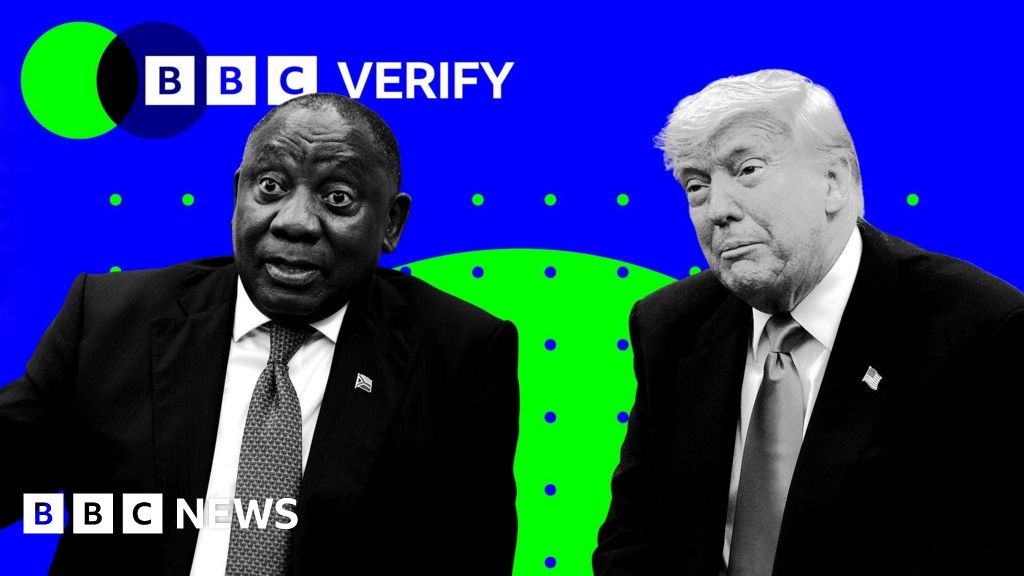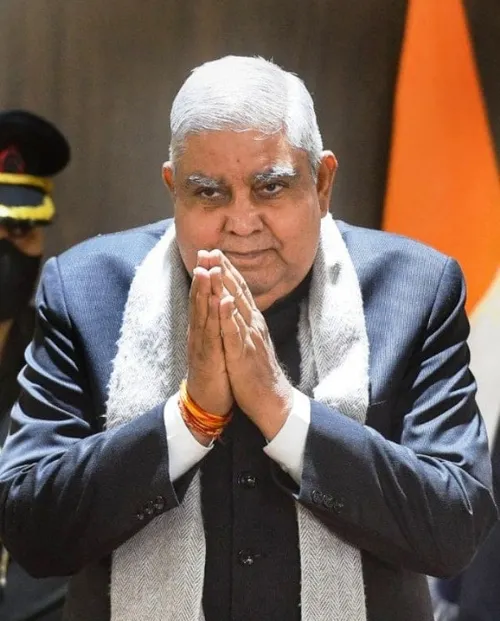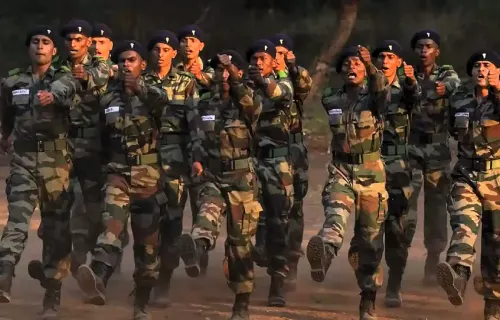BBC Verify
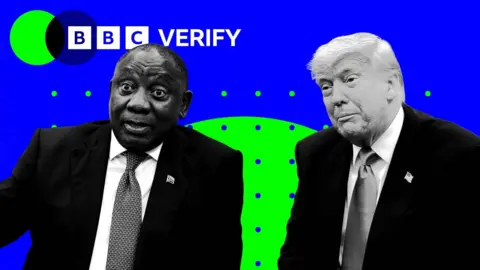 BBC
BBCDonald Trump confronted President Cyril Ramaphosa during a tense exchange in the White House on Wednesday, with a series of contested claims about the killings of white farmers in South Africa.
The meeting – at first warm and light-hearted – quickly changed tone as Trump asked his staff to play a video showing opposition South African politicians calling for violence against white farmers.
Trump also played footage showing rows of crosses, which he claimed was a burial site for murdered white farmers, and presented Ramaphosa with copies of articles which he said documented widespread brutality against South Africa’s white minority.
Supporters of the Trump administration have long amplified claims of violence against the white minority, notably Elon Musk and former Fox News host Tucker Carlson, who ran segments on the supposed genocide during the president’s first term. Some of these claims are demonstrably false.
Did rows of crosses mark graves of white farmers?
The footage played by Trump in the Oval Office showed rows of white crosses stretching off into the distance along a rural road. Trump claimed: “These are burial sites right here. Burial sites. Over a thousand of white farmers.”
However, the crosses do not mark graves. The video is from a protest against the murder of white farming couple Glen and Vida Rafferty, who were ambushed and shot dead on their premises in 2020. The clip was shared on YouTube on 6 September, the day after the protests.
“It’s not a burial site, but it was a memorial,” Rob Hoatson, one of the organisers of the event, told the BBC. He said the crosses were erected as a “temporary memorial” to the couple.
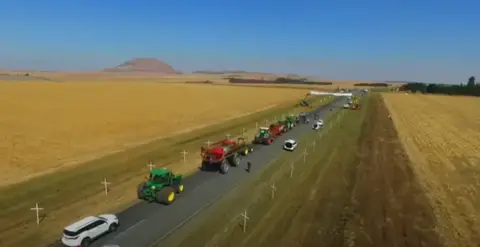 YouTube
YouTubeMr Hoatson said the crosses have since been taken down.
BBC Verify has geolocated the footage to an area in KwaZulu-Natal province, near the town of Newcastle. Google Street View imagery captured in May 2023 – almost three years after the footage first appeared online – shows that the crosses were no longer standing.
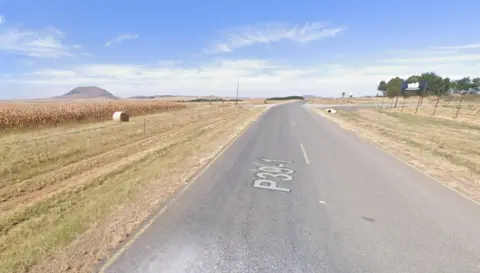 Google
GoogleHas there been a genocide of white farmers?
In the meeting, Trump said: “A lot of people are very concerned with regard to South Africa… we have many people that feel they’re being persecuted, and they are coming to the US, so we take from many locations if we feel there’s persecution or genocide going on.”
He has previously made claims about “white genocide” several times before and appeared to be referring to that.
At a press briefing earlier this month he said: “It’s a genocide that’s taking place” referring to killing of white farmers in South Africa.
The country has one of the highest murder rates in the world. There were 26,232 murders last year, according to South African Police Service (SAPS) figures.
Of these, 44 were killings of people within the farming community and of those, eight were of farmers.
These figures are not broken down by race in any public stats release that we’ve been able to locate – but they clearly don’t provide evidence for the claims of “white genocide” made repeatedly by Trump.
In February, a South African judge dismissed the idea of a genocide as “clearly imagined” and “not real”.
The Transvaal Agricultural Union (TAU), which represents farmers, compiles figures which offer an insight into the racial identity of the victims. The TAU relies on media reports, social media posts and reports from their members.
Their figures for last year show there were 23 white people killed in farm attacks, and nine black people. So far this year TAU has recorded three white people and four black people killed on South African farms.
Did South African officials call for violence against white farmers?
During the tense meeting, Trump played footage from political rallies in which participants sang “Kill the Boer” – a controversial anti-apartheid song that critics say calls for violence against white farmers.
South African courts had categorised the song as hate speech, but recent judgements have ruled that it can be legally sung at rallies as judges say it makes a political point and does not directly invoke violence.
Trump said that those leading the singing were “officials” and “people that were in office”.
One of the men leading the rally was Julius Malema, who previously led the ruling ANC’s youth wing. In 2012 he left the party and has never held an official government position. He now leads a party called the Economic Freedom Fighters (EFF) which won 9.5% in last year’s election, entering opposition against the new multi-party coalition.
 Getty Images
Getty ImagesResponding to Trump’s accusations, Ramaphosa emphasised that the EFF is “a small minority party” and said that “our government policy is completely against what he was saying”.
Another man in the video who can be heard singing the lyric “shoot the Boer” at a different rally is former President Jacob Zuma, who left office in 2018. The video is from 2012 when he was president. The ANC promised to stop singing the song shortly afterwards.
Zuma subsequently left the ANC and now leads the opposition uMkhonto weSizwe (MK) party, which won more than 14% in last year’s election.
What documents did Trump present as evidence?
During the meeting, Trump held up a series of articles which he claimed showed evidence of white farmer killings in South Africa.
There was an image clearly visible as Trump spoke and said: “Look, here’s burial sites all over the place. These are all white farmers that are being buried.”
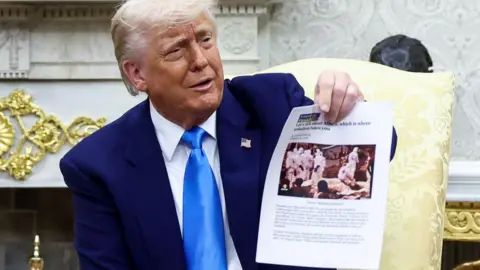 Reuters
ReutersBut the image isn’t from South Africa – it’s actually from a report about women being killed in the Democratic Republic of Congo.
The French news agency (AFP) initially pointed out the image, and BBC Verify ran a search and confirmed it as being from a Reuters news agency clip filmed in the DR Congo city of Goma in February.

Anurag Dhole is a seasoned journalist and content writer with a passion for delivering timely, accurate, and engaging stories. With over 8 years of experience in digital media, she covers a wide range of topics—from breaking news and politics to business insights and cultural trends. Jane's writing style blends clarity with depth, aiming to inform and inspire readers in a fast-paced media landscape. When she’s not chasing stories, she’s likely reading investigative features or exploring local cafés for her next writing spot.
